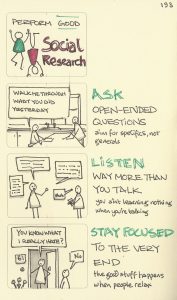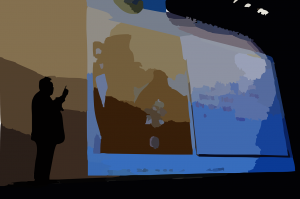33 Research: Finding and Citing Your Research
This chapter is attributed, in its entirety to Lynn Mead
Research: Finding and Citing Your Research
LYNN MEADE

Supposing is good,
but finding out is better.
Mark Twain, writer
This chapter is about being strategic with how to find your research, how to evaluate the research you find, how to smoothly work information into your speech, and how to adapt your reference page to the presentation context. Since this is an advanced public speaking book, I am going to assume you already know the basics about how to access primary research sources. My goal is for you to take what you know about research and dig a little deeper. I also want you to think about how to use your research differently to adapt to the context.
Advanced Tips on Research
1. Brainstorm
You should thoroughly brainstorm your topic in writing before you ever begin researching. Make a list of possible words you would look up. Anytime you do this type of brainstorming, your goal should be to have at least 20 words. For example, if I wanted to give an informative speech on the impact of a teacher’s body language on student learning, I might look up any of these words–notice the variety of angles as well as how I have listed several ways of saying the same thing.
- body language
- nonverbal
- immediacy behaviors
- gestures
- eye contact
- occulesics
- personal space
- dress
- proxemics
- education
- educator
- teaching
- teacher
- university
- pedagogy
- college
- classroom
- learning
- student
- evaluations
2. Research Your Topic Broadly
Vary your research by looking up different types of research from different types of sources. Don’t just “google it.” (Yes, I like to use internet search engines, but that should not be all you do.) Look up books on the topic, look up art on the topic, look up statistics on the topic, use a library periodical search engine on your topic. I am sure you have heard this before, but I am reminding you–mostly because I need to be reminded. Resist the temptation to do just one type of research.
You should also diversify your research. Look at the authors of your research, do they represent various genders, ethnicities, and political leanings? Try being intentional with varying your research. Seeking a variety of voices on your topic leads to some varied and interesting perspectives.
3. Interview Someone

One semester, I required all my students to do an interview for their speeches. At the end of the speech day, I asked them, What stood out about the speeches? What really helped you to be drawn in? One of the most frequent answers had to do with the interview. When possible, do an interview as part of your speech research.
One of the added bonuses of doing interviews is you can use it to make a new professional contact. Use your speech research to do networking, you might be surprised that you come out with a new contact or maybe a future job opportunity.
When you talk about the interview in your speech, be sure to tell the audience who you interviewed and the credentials of the person you interviewed. It is also helpful to include why you chose to interview that person. Take a picture of the person you interviewed or their office and if it seems right for your presentation, include the photo in your slides.
Brainstorm interview prospects
- Who can you interview on your topic?
- Who is a professional in the field?
- Who could you talk to who has a lived experience related to your topic?
- Who is a professional you have always wanted to talk to and needed a good excuse to get your foot in the door?
When conducting an interview always:
- Ask open-ended questions.
- Listen way more than you talk.
- Stay focused to the very end.
- Send a thank-you note.

Food For Thought
When researching for a ceremonial speech–eulogy, wedding toast, retirement speech, birthday speech–it is helpful to talk to other people who know the person you are celebrating. This type of research usually produces information you wouldn’t have otherwise considered.
4. Look up Something Weird

Using Your Research in a Speech
Oral Citations: Using Your Research in a Speech
When mentioning your research in your speech, you should always give an oral citation. Depending on the type of speech and the type of audience, this would be done differently. Citations are about credibility–ethos. When you use high-quality sources, it instills trust in the minds of your audience. They trust the information that you are giving, and they trust you as a person.
When I was on the debate team, we had to say the entire citation…every single word of it….the author, date, article title, and the publication and issue number. For debaters talking to other debtors, this type of complete citation worked. Outside of that context, it is just too much information, and the audience gets bored. The trick is to find the balance that allows you to share key parts of your citation without losing the audience’s attention.
Instead of speaking every single part of the citation, find the part that is the most familiar to the audience (like a prominent name or publication) and speak the parts of the reference that enhances your credibility.
- If the information is from a known magazine or journal, you should mention that.
- If the article comes from a respected author that the audience knows, you should mention them.
- If the person you are citing has a title that is relevant, you should mention that.
- If the research is time-sensitive, you should mention the year of publication.
The key here is to be intentional about which part of the citation you speak. To further, illustrate this, I want to show you the difference between what you say in your speech, how you would write it on a full-sentence outline, and then how it would look on your reference page.
(These samples are in APA)
This is what you would say in your speech.
According to an article on consumer perception of coffee published in Nutrients Journal, those who were surveyed said young males are more likely to be inclined to believe there are health benefits from drinking coffee. In a market where there is increased interest in healthy food, there is room to improve the perception of coffee and the scientifically-based health benefits.
(Nutrients Journal carries the credibility of a journal. Mentioning the authors would be optional. Since most people don’t know who they are, it doesn’t help with the credibility.)
This is what it would look like on your outline.
According to an article on consumer perception of coffee published in Nutrients Journal those who were surveyed said young males are more likely to be inclined to believe there are health benefits from drinking coffee (Samoggia & Riedel, 2019).
This is what you would put on the reference page.
Samoggia, A., & Riedel, B. (2019). Consumers’ perceptions of coffee health benefits and motives for coffee consumption and purchasing. Nutrients, 11(3), 653. doi:http://dx.doi.org/10.3390/nu11030653
This is what you would say in your speech.
An article published in the Nutrition and Food Science Journal titled, “To sip or not to sip: The potential risks and benefits of coffee drinking” coffee drinking can reduce the risk of type 2 diabetes, Alzheimer’s disease, and Parkinson’s disease.
(The title of the article is interesting, and the mention of a Journal gives credibility. Once again, I wouldn’t mention the authors since most people don’t know them.)
This is what it would look like on your outline.
An article published in the Nutrition and Food Science Journal titled, “To sip or not to sip: The potential risks and benefits of coffee drinking” coffee drinking can reduce the risk of type 2 diabetes, Alzheimer’s disease, and Parkinson’s disease. (Taylor & Demming-Adams, 2007).
This is what you would put on the reference page.
Taylor, S. R., & Demmig-Adams, B. (2007). To sip or not to sip: The potential health risks and benefits of coffee drinking. Nutrition and Food Science, 37(6), 406-418. doi:http://dx.doi.org/10.1108/00346650710838063
This is what you would say in your speech.
As I was working on this eulogy for today, I talked to a couple of family members and asked them what they most remember about grandpa. Cousin Zena said she remembers him for always wearing bibbed overalls, an International Harvester hat, and for having shoes the size of cars. Most of all, she remembers his laugh.
(In this case, the audience only needs to know the names and relationships. No need for formal titles or last names if the people are familiar)
This is what it would look like on your manuscript.
As I was working on this eulogy for today, I talked to a couple of family members and asked them what they most remember about grandpa. Cousin Zena said she remembers him for always wearing bibbed overalls, an International Harvester hat, and for having shoes the size of cars. Most of all, she remembers his laugh.
This is what you would put on the reference page.
Meade, Z. (2021, May 8). Personal Interview.
Let’s be honest, in a real eulogy, you would not turn in a reference page. If you are in a college class, it will be required of you to establish the practice of citing your sources.
This is what you would say in your speech.
According to the Hobby Lobby website, wheeled glass nippers will cost you $16. These will be essential for cutting glass for your mosaic.
This is what it would look like on your outline.
According to the Hobby Lobby website, wheeled glass nippers will cost you $16. These will be essential for cutting glass for your mosaic (2021).
This is what you would put on the reference page.
Hobbylobby.com (2021) Wheeled Glass Nippers.
This is what you would say in your speech.
According to the article, How to Host Your Own Coffee Tasting on the Starbucks website, when formally coffee tasting, you should slurp your coffee to allow the coffee to spray across your tongue and palate.
This is what it would look like on your outline.
According to the article, How to Host Your Own Coffee Tasting on the Starbucks website, when formally coffee tasting, you should slurp your coffee to allow the coffee to spray across your tongue and palate (Starbucks, 2020).
This is what you would put on the reference page.
Starbucks. (n.d) Host your own coffee tasting. Retrieved May 8, 2020, https://athome.starbucks.com/host-your-own-coffee-tasting/
COMM Activity for Lori’s Class
Create you own citations to share in the weekly discussion and/or flip post:
- Prepare: find your 3 sources
- Write your Works Cited and Post in the Dropbox.
- Create the following for each source and share your screen with your FLIP post
- This is what I would say in my speech. *Note, use the “peanut butter and jelly” method we practiced before.
- This is what it would look like on your outline.
- This is what you would put on the reference page.
Do Not Say This
- “According to google.” Google is not a source; it is a search engine. The equivalent would be to say, according to the university library. The library is where you find the information, not the information itself.
- “According to homedepot.com.” You would never say, “According to 210 South Main Street, Fayetteville, Arkansas because that is an address. When you say “.com” you are citing an address. Don’t site a person’s address or a webpage’s address as your source. You can say, “according to the home depot website.”
- “And my source is…” When saying your source, use the name of the specialist or the name of the article and journal. No need to tell us it is your source; we will figure that out.
- “Quote/Unquote.” Say the author and the quote, no need to say the word “quote.”
- “Thank you and now here are my sources.” You do not need to show your audience your references on your slide show. To make sure your audience doesn’t accidentally see your reference page, put two blank slides at the end of your presentation and then add your references. Putting them with your slides keeps them available for anyone who wants a copy of your slides.
Fake-istotle Quotes
While I was researching Aristotle, some amazing quotes came up as Aristotle quotes. The only problem is, he didn’t say them. While I was hunting down the original author, I found a website called Fake-istotle Quotes.
Why is this relevant? It demonstrates one of the many challenges of internet research– typically one person puts it out there and then others copy it. You should be a sleuth and hunt down the originals and you should sniff out faulty research. Don’t just copy the work of others, look for the original.
Good quotes, Aristotle just didn’t say them.
- We are what we repeatedly do, excellence then is not an act but a habit. Will Durant
- Mark of an educated man is to entertain a thought without accepting it. Someone other than Aristotle
Does Your Research Pass the CRAAP Test?
Once you have found your research, you should test it to make sure it is credible. Check your research for currency, reliability, authority, accuracy, and purpose using the CRAPP test.
Currency
- When was it published?
- Has it been revised since then?
- Is it current enough for your topic?
- Is it a topic where the opinions about it change over time?
Reliability //Relevance
- Can you depend on the information and trust it to be accurate?
- Is the information biased?
- Is the information the appropriate complexity for the type of project I am working on?
- Does it provide reliable sources to back up claims?
Authority
- Can you trust the source where you found the information?
- Is the author an authority or do they cite subject authorities?
- Are they reputable?
- If the material is taken from other sources, do they credit/cite those sources?
- What does the URL end with? (.gov, .org, .edu, .com?) If not, how are you determining its reliability?
Accuracy
- Can you trust the reliability of the information?
- Is the information correct? How would you know?
- Can you verify any of the information from another source?
- Do the links lead to useful information corroborating the site’s statements, or do they link to questionable information?
Purpose/Point of View
- What is the author’s motivation for publishing the resource?
- Is the author trying to inform, persuade, or entertain you?
- Does the author appear to have an ax to grind or seem blindly committed to their cause?
- Are they using this information to make money off of users?
- Is there any conflict of interest?
This video gives a great analysis of a couple of sources using the CRAPP test.
https://www.youtube.com/watch?v=lhwB4zQD4XA&t=139s
Researching Images
Searching, finding, and using images is a type of research too. Just like text-based research, you should provide citations and give credit.
Searching for Images
When searching for images to use, you should seek out images the have a creative commons copyright or are open for use. Here are a couple of my favorite sites.
Don’t forget to reference your image on your reference page and on your slides.
- Creativecommons.org
About: “CC Search is a tool that allows openly licensed and public domain works to be discovered and used by everyone. Creative Commons, the nonprofit behind CC Search, is the maker of the CC licenses, used over 1.4 billion times to help creators share knowledge and creativity online.” - Unsplash.com
About: All items on Unsplash can be used for free. You can use them for commercial and noncommercial purposes. You do not need to ask permission but giving credit to the photographer is appreciated.
- Eduimages
About: A free library of photos celebrating students—and the educators who teach them—in seven schools across the United States. - Gettyimages
About: The Getty makes available without charge, all available digital images to which the Getty holds the rights or that are in the public domain to be sued for any purpose. No permission is required. - Wikimedia Commons
About: Wikimedia Commons is free. Everyone is allowed to copy, use and modify any file here freely as long as they follow the terms specified by the author. The conditions of each media file can be found on their description page. - Pixabay
About: All images and videos on Pixabay are released free of copyrights under Creative Commons CC0. You may download, modify, distribute, and use them royalty-free for anything you like, even in commercial applications. Attribution is not required.
Reference Page
The reference page is where you list all the sources that you used in your speech. This means the books, articles, and internet information that you use as well as any interviews, images, videos, and charts.
What Do You Do with Your Reference Page?
What you do with your reference page is going to be different based on context. Many of you are in a college speech class, which means that you will give your teacher a digital or physical copy of your reference page. I want you to be prepared for speeches outside the college classroom, so let’s look at how to use a reference page in a variety of contexts.
| College Presentation | If you are in a college class, your teacher will likely ask you to turn in a copy of your reference page. You should have it typed and it should include your name.
Double-check which style (APA, MLA, Chicago, etc) that your teacher wants you to use and follow precisely the rules of that style. For tips on using APA, go to OWL Purdue APA
|
| Academic Conference Paper Presentation | Academic talks often come from research papers. Typically, you will upload your paper and reference page into a database before the conference. Sometimes, they ask for your slides as well. If that is the case, you should include a final slide to your slideshow that includes your references. You would not actually show that slide during your presentation, but it is available for those who want to download your presentation slides.
If you are giving a poster talk, you will want to have copies of your paper with references to hand out. Make a handout that is a photo of your poster on one side and key references and your name on another. Make sure your name is on it and think of it as a business card that people might keep to remember you and your research.
|
| Academic Conference Table talk Discussion group Non-paper presentation |
It is likely those in attendance will want a copy of your slides. You should anticipate this and have a reference page on your slides. You would not show your reference page during your talk, but it is there for those who want a copy of your slides.
Handout. I prefer giving audiences a printed or digital handout instead of giving them my slides. I can customize a handout to give only the information that someone would want to look at after the talk. In that scenario, I only include the references that they would want to look up to gain more information.
|
| Business Talk | Put your reference page on your presentation slides but don’t show them during your presentation. If someone wants a copy of your slides, you have the references included.
(Tip: At the end of the slideshow, add two blank slides before your reference page, that way you don’t accidentally show them during your presentation)
|
| Community Talk or Training | Pass out a handout that includes relevant references where they can look up more information or create an online resource where they can get the information. |
| Sales Talk | Most companies have a sales brochure that they give a customer. Ideally, they should include references or point to references on a website.
You should be willing to give references if asked. It is a good idea to make a reference page when you prepare your sales presentation and have it in case you need it. |
Reference Page
For reference, I have included a sample reference page in APA.
Reference Page Sample APA
- “References” should be at the top.
- Alphabetize references.
- Use a hanging indent
- Every line is double-spaced. (This sample is not correct because of the way this program formats. Every line should be double space with no single-spaced items).
For reference on this look at this sample student paper from OWL Purdue-the reference page in on page 17.
References
Hobbylobby.com (2021) Wheeled Glass Nippers.
Meade, Z. (2021, May 8). Personal Interview.
Samoggia, A., & Riedel, B. (2019). Consumers’ perceptions of coffee health benefits and motives for coffee consumption and purchasing. Nutrients, 11(3), 653. doi:http://dx.doi.org/10.3390/nu11030653
Starbucks. (n.d) Host your own coffee tasting. Retrieved May 8, 2020, https://athome.starbucks.com/host-your-own-coffee-tasting/
Taylor, S. R., & Demmig-Adams, B. (2007). To sip or not to sip: The potential health risks and benefits of coffee drinking. Nutrition and Food Science, 37(6), 406-418. doi:http://dx.doi.org/10.1108/00346650710838063
Understanding Peer Review and Scholarly Sources
I want to make sure that you understand peer review and scholarly sources since it is an area that some struggle to grasp. When someone says they are wanting you to reference scholarly sources, typically they are talking about items that have been through the peer-review process. According to OWL Purdue, “One major character of scholarly sources is that they are peer-reviewed. Here’s how a scholarly source typically goes through the process:
- A scholar/author writes an article and submits it to the editor of a journal or book.
- The editor sends it to other scholars who are at least the academic peers (equals) of the author in that field.
- The reviewers review or vet (examine) it, then tell the editor whether they think it’s good enough to be published in that journal or what should be changed.”
Oftentimes your speech is required to have peer reviewers or scholarly articles, it is important that you are able to understand why peer review articles are different and how to access them. I included this video to help you understand.
What is Peer Review, Scholarly Article?
You may be asked to use peer-reviewed/scholarly/refereed articles for your research. It is important to understand the process in order to understand why this is a more advanced type of research.
https://youtube.com/watch?v=rOCQZ7QnoN0%3Fstart%3D9%26feature%3Doembed
Please share your feedback, suggestions, corrections, and ideas.
I want to hear from you.
Do you have an activity to include?
Did you notice a typo that I should correct?
Are you planning to use this as a resource and do you want me to know about it?
Do you want to tell me something that really helped you?
In summary, it is important to know how to research your speech properly and to reference those sources in a way that gives credibility to your topic.
References
AskUs NCSU Libraries. (2014). Peer Review in 3 Minutes. [Video]. YouTube. https://www.youtube.com/watch?v=rOCQZ7QnoN0&t=9s Standard Youtube License.
Houston Community College Libraries. (2021). Evaluating sources: C.R.A.P. Test. https://library.hccs.edu/evaluatingsources/test
Huntress, C. (2017). My favorite quote of all time is a misattribution. https://medium.com/the-mission/my-favourite-quote-of-all-time-is-a-misattribution-66356f22843d
Portland State University Library (2012). The C.R.A.P. Test in action. https://www.youtube.com/watch?v=lhwB4zQD4XA&t=139s
Purdue University. English 106/108: Scholarly Sources and Peer Review. https://guides.lib.purdue.edu/eng106/scholarly-sources-and-peer-review
Samoggia, A., & Riedel, B. (2019). Consumers’ perceptions of coffee health benefits and motives for coffee consumption and purchasing. Nutrients, 11(3), 653. doi:http://dx.doi.org/10.3390/nu11030653
Sheets, R. (2021, May 18). Personal Interview. (Director of the Business Communication Lab, Walton College of Business. University of Arkansas).
Spencer, J. [https://twitter.com/spencerideas]. (July 3, 2018). Research should be fun. It should feel like geeking out. Twitter. Retrieved May 19, 2021, from https://twitter.com/spencerideas/status/1014178267820118018/photo/1
Taylor, S. R. & Demmig-Adams, B. (2007). To sip or not to sip: The potential health risks and benefits of coffee drinking. Nutrition and Food Science, 37(6), 406-418. doi:http://dx.doi.org/10.1108/00346650710838063
University of Arkansas Library Research Guide. CRAAP Test for evaluating. https://uark.libguides.com/BENG4933/Evaluation
*CRAAP test developed by Meriam Library, California State University, Chico
Media Attributions
- Girl on computer © Surface is licensed under a CC BY (Attribution) license
- sketchplanations social research is licensed under a CC BY (Attribution) license
- christina-wocintechchat-com-LQ1t-8Ms5PY-unsplash © Christina is licensed under a CC BY (Attribution) license
- Man on stage © Product School is licensed under a CC BY (Attribution) license
- Tape over mouth © Jackson Simmer is licensed under a CC BY (Attribution) license
- Presenter-visual © Pixabay is licensed under a CC0 (Creative Commons Zero) license




